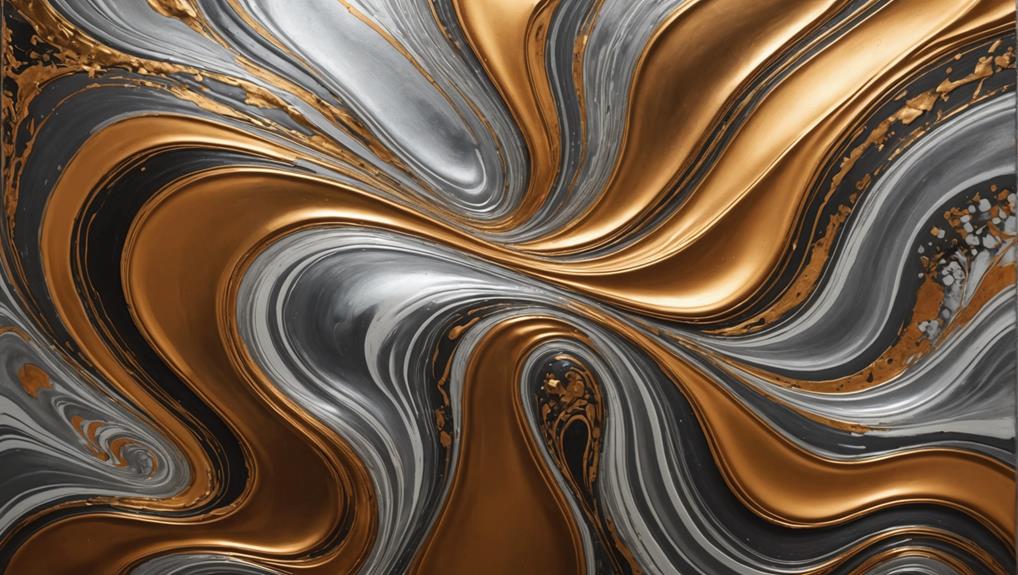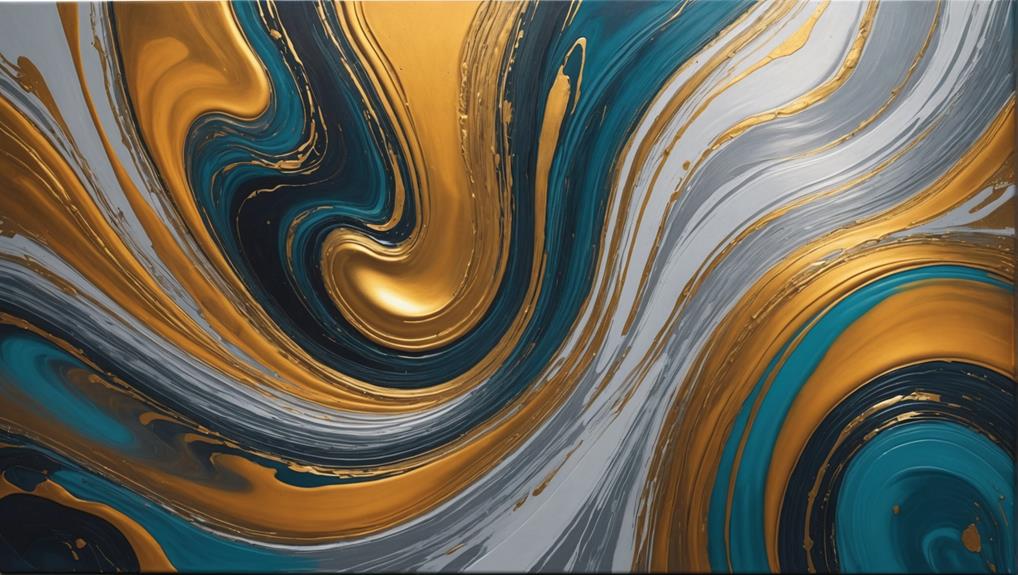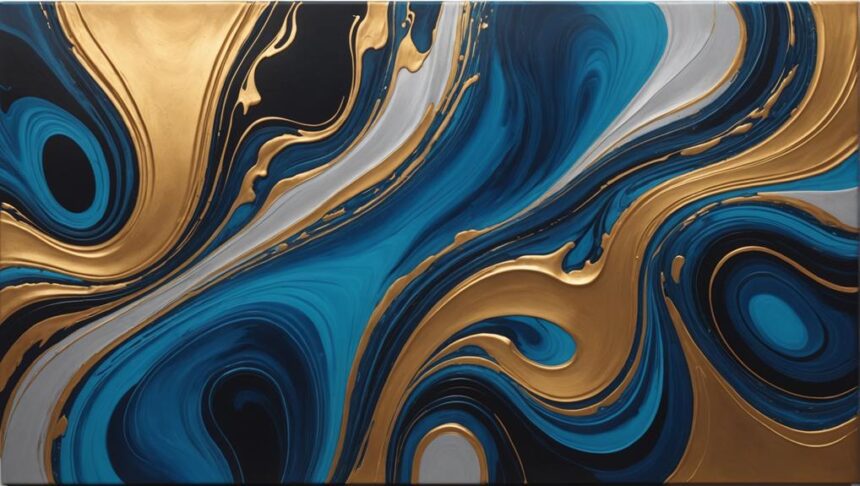Using metallics in fluid art can make your paintings look magical, with shimmering golds, silvers, and bronzes that catch the light and turn heads. Start by prepping your canvas with gesso, and choose a liquid pouring medium to blend your metallic paints, ensuring smooth, flowing textures. Testing different brands is essential since they vary in sheen and drying time, making your art unique and exciting. As your masterpiece dries, the metallics will reveal stunning textures and vibrant patterns, enhancing the visual appeal. If you’re ready to turn your fluid art into a dazzling showcase, just wait until you find out what comes next!
Key Takeaways
- Mixing metallic paints with a liquid pouring medium enhances flow and maintains pigment intensity.
- Testing different brands of metallic paints helps to predict sheen, viscosity, and drying behavior.
- Using a base color like Mars black increases contrast and highlights the metallic shimmer.
- Observing paint behavior during drying reveals textural variations and enhances understanding of outcomes.
Essential Materials
Creating stunning metallic fluid art requires a careful selection of essential materials to guarantee successful outcomes. At the heart of this creative process are the metallic mediums, which bring a shimmering, iridescent quality to the artwork. These mediums include a variety of metallic paints, each contributing unique reflective properties that enhance the aesthetic appeal of the piece.
A significant aspect to contemplate is paint viscosity. Achieving the right viscosity guarantees that the paint flows smoothly across the canvas, allowing for seamless blending of colors and intricate patterns. To adjust paint viscosity, artists often add a liquid pouring medium, which dilutes the paint without compromising its pigment intensity. This step is critical for creating the fluid, dynamic effects characteristic of metallic fluid art.
Additionally, water is used to further fine-tune the consistency of the paint, guaranteeing it is neither too thick nor too thin. The unpredictable behavior of different brands of metallic paints makes it essential to test and adjust each one accordingly.
A 20 by 20-inch gallery-style canvas provides ample space for the metallic paints to spread and interact, resulting in a mesmerizing final composition that showcases the artist’s skill and creativity.
Selecting Metallic Colors
When choosing metallic colors for your fluid art, it’s essential to think about how different shades will work together, like a vibrant gold next to a rich purple pearl.
Remember that each brand of metallic paint might behave differently, so testing them first can save you from surprises.
Balancing metallics with a base color like Mars black can really make them pop, creating an eye-catching contrast in your artwork.
Color Compatibility Considerations
Selecting metallic colors for fluid art requires careful thought of hue combinations to achieve a harmonious and visually appealing composition.
By understanding color theory and mastering hue blending, artists can create dynamic and enchanting works. Combining metallic hues like splendid gold, festive red, and purple pearl can produce a vibrant and colorful effect that catches the eye.
When planning your palette, reflect on how different colors will interact. For instance, pairing metallics with Mars black can enhance contrast and depth, making the metallics pop.
Experimenting with various combinations allows you to discover which hues complement each other best, creating a balanced and striking piece.
It’s also essential to take into account the flow and consistency of your paints. Using a liquid ex-porn medium can help dilute metallic paints, ensuring they blend smoothly and maintain their shimmer.
Observing the drying process is vital, as metallics may change appearance once dried, influencing the final look of your artwork.
Brand-Specific Metallic Behaviors
Different brands of metallic paints can considerably impact the sheen, viscosity, and drying time, thereby influencing the final outcome of fluid art pieces. This is important because brand differences mean that two gold paints might not behave the same way on your canvas.
Some brands produce a high sheen that catches the light beautifully, while others might offer a subtler, matte-like finish. Sheen variations can really change the vibe of your artwork, making it essential to experiment with different brands to find what works best for your vision.
Imagine trying out splendid gold from Brand A and noticing it dries quickly but has a duller finish. Then, you switch to Brand B’s festive red, which has a longer drying time, allowing the paint to settle and create more texture.
This process of trial and error is significant in fluid art. Testing how purple pearl from another brand interacts can add yet another layer of complexity to your piece. Utilizing a liquid pouring medium can also help achieve smoother applications, maintaining the vibrant characteristics of the metallics.
Balancing Metallic and Matte
In fluid art, achieving a balance between metallic and matte finishes requires careful selection of colors to create a harmonious and visually striking composition. Imagine you’ve got a palette of dazzling options like splendid gold, festive red, purple pearl, bright copper, festive green, teal, and berry. These colors can make your artwork pop, but it’s essential to manage the shine control effectively.
Before getting started, remember that metallic paints from different brands can behave unpredictably. It’s like a science experiment where you have to test and see which combinations work best for your masterpiece. Once you’ve nailed down your choices, think about metallic layering. This technique can add depth and dimension to your piece. However, too much shine can sometimes be overwhelming.
Enter Mars black, your new best friend. By adding it to your palette, you create striking contrasts that make those metallics stand out even more.
After your artwork dries—give it a good 16 hours—consider applying a matte varnish. This step is like putting on sunglasses; it tones down the glare while keeping the colors vibrant.
Observing how metallics react as they dry can also give you insights for future projects.
Preparing Your Canvas
To prepare your canvas for fluid art, begin by choosing a gallery-style canvas, ideally sized at 20 by 20 inches, to guarantee a sturdy and suitable base for your metallic creations. Proper canvas preparation is vital for achieving a professional finish. Start by confirming the surface is primed; this step helps the paint adhere better and prevents any unwanted absorption.
Here are four steps to get you started:
- Pre-paint the Sides: Before diving into your artistic process, pre-paint the sides of the canvas. This guarantees a cohesive look and prevents unpainted edges from distracting from your final piece.
- Prime the Surface: A well-primed surface is key. Use gesso to coat the canvas, allowing it to dry thoroughly. This creates a smooth, uniform base, perfect for fluid art.
- Dilute with Medium: Mix your metallic paints with a liquid pouring medium. This step not only enhances the paint’s flow but also maintains its consistency, essential for fluid dynamics.
- Adjust Consistency: Fine-tune the paint’s texture with water as needed. Different metallic brands have varying viscosities, so achieving the right balance guarantees the paint moves and blends seamlessly.
Application Techniques
Once your canvas is properly prepared, exploring various application techniques will enable you to fully harness the dynamic properties of metallic paints.
One interesting method involves using finger techniques, which can create unique textures and movement, enhancing the overall depth of your artwork. By directly manipulating the paint with your fingers, you can achieve a tactile connection to your piece, allowing for intuitive adjustments and expressions.
Another approach to take into account is the incorporation of a liquid pouring medium. This medium helps to dilute the metallic paints, enabling a smoother application and consistent flow. The use of a pouring medium can also assist in texture creation, as the paint will spread more evenly across the canvas, allowing for intricate patterns and variations.
Experimenting with different brands of metallic paints is essential, as their behavior can vary greatly during the drying process. Some may dry to a high gloss, while others may have a more subdued shimmer.
Ultimately, the key to mastering metallics in fluid art lies in your willingness to experiment and adapt. By trying out various techniques and observing the results, you can discover the unique characteristics of each paint and medium, creating stunning, dynamic pieces.
Observing Paint Behavior

When working with metallic paints in fluid art, it’s fascinating to observe how they behave as they dry, revealing surprising dynamics and creating mesmerizing textural variations.
Watching the paint transform over time, especially when different brands are used, can show just how unique each piece can become.
The drying time is essential too, as it’s during this phase that the most striking effects, like shimmering highlights and vibrant colors, truly come to life.
Dynamics of Metallic Paints
Metallic paints in fluid art often display complex and dynamic behaviors during both application and drying phases. These behaviors can be thrilling to observe, especially when considering factors like metallic layering and shine enhancement.
Here are some key aspects to watch for:
- Metallic Layering: As metallic paints spread and interact, they create layers that can produce stunning visual effects. The interplay between different metallic shades often results in a mesmerizing depth and richness.
- Shine Enhancement: During the drying process, the shine of metallic paints can either intensify or subtly shift, maintaining a vibrant and reflective quality. This effect can make your artwork look almost as dazzling dry as it does wet.
- Unpredictable Behavior: Different brands of metallic paints may react uniquely, leading to unexpected and fascinating outcomes. This unpredictability adds an element of excitement and surprise to the creative process.
- Time-lapse Recording: Capturing the drying process through time-lapse can be incredibly insightful. It allows you to see how the paints evolve and transform, providing valuable information for future projects.
Experimenting with these aspects can lead to truly unique and enchanting fluid art pieces, making the journey as enjoyable as the final result.
Textural Variations Observed
Textural variations in fluid art become particularly evident as metallic paints begin to dry, revealing unique patterns and surfaces. This drying process often brings out unexpected behaviors in the paint, making each piece truly one-of-a-kind.
For example, as the metallics dry, they create a fascinating array of textural contrasts that can range from smooth and glossy to rough and textured. This adds a layer of visual depth that grabs the viewer’s attention.
When multiple metallic paints are used, the effect is amplified, resulting in a vibrant and dynamic composition. The shimmering quality of metallics, which closely resembles their wet appearance even after drying, adds an extra dimension of visual interest. It’s like watching a magic trick where the artwork transforms right before your eyes!
Observing the paint behavior in real-time is vital for artists. It allows for spontaneous adjustments, like adding extra sprays to achieve the desired effect.
Techniques such as using fingers to manipulate the paint can also impact the final texture, creating movement and dimension that make the piece stand out. All these elements combine to produce a final artwork that is not just visually appealing but also rich in texture and complexity.
Drying Time Effects
Regularly monitoring the drying process of metallic paints is vital for understanding the unique reactions and effects that develop over time. This observation period can reveal fascinating insights into how metallic paints behave, especially regarding drying reactions and shine evolution.
- Initial Hour Observations: During the first hour of drying, metallic paints start to reveal their shiny and vibrant nature. It’s like watching a magic show unfold, as the colors and textures begin to shift and shimmer.
- Mid-Drying Phase: By the midpoint, around 8 hours in, unique reactions can be observed in specific areas of the artwork. These can include fascinating textural changes or unexpected color blends, thanks to the liquid ex-porn medium.
- Drying Completion: After roughly 16 hours, the paint fully dries, solidifying the patterns and shine. The end result showcases the evolution of shine from a wet to a dry state, often more intense and striking than initially anticipated.
- Post-Drying Care: It’s important to wait several days before applying varnish. This waiting period guarantees the paint has fully settled, which helps manage and enhance the final shine, giving your artwork that professional finish.
Keeping an eye on these stages helps you better understand and predict the outcomes of your metallic fluid art projects.
Managing Drying Time
Understanding the intricacies of drying time is vital for achieving ideal results in metallic fluid art. When it comes to drying techniques, one must consider various environmental factors that can impact the process. For example, the total drying time can take approximately 16 hours, but this can vary based on the type of paint and the conditions in your workspace, such as temperature and humidity.
It’s important to monitor the paint as it dries because metallics can behave differently, sometimes creating unexpected but beautiful effects. Patience is key! You don’t want to rush this step, as the final look often mirrors the wet appearance, which means waiting will reward you with vibrant and shimmering results.
Another fun tip is to experiment with additional spray techniques during the drying phase. This can add unique textures and enhance the overall appearance of your piece.
Reflecting on Results

Reflecting on the results of using metallics in fluid art reveals both the potential for stunning visual effects and the importance of understanding paint behavior. The drying process, which took approximately 16 hours, showcased a vibrant, shiny outcome, closely resembling the wet look. Unique reactions in certain areas highlighted the unpredictable nature of metallic paints, varying by brand. Capturing these changes with a time-lapse recording provided real-time insights into paint behavior, proving invaluable for future artistic experimentation.
Here are some key takeaways:
- Shimmer and Vibrancy: The final appearance confirmed the effectiveness of using multiple metallics to achieve a colorful, shimmering effect.
- Unpredictable Reactions: Different brands of metallic paints can react uniquely, making each piece a distinctive work of art.
- Time-Lapse Benefits: Recording the drying process offers valuable insights, allowing artists to observe and learn from real-time changes.
- Future Exploration: Experimenting with fewer colors and more black could yield interesting results, opening new avenues for creative inspiration.
Embracing these reflections encourages continuous artistic experimentation, aiding artists in mastering the enchanting medium of metallic fluid art.
Frequently Asked Questions
What Color Combinations Are Best for Fluid Art?
For fluid art, the best color combinations involve bold contrasts such as splendid gold with festive red, or a limited palette like Mars black with metallics, and complementary colors like teal and berry to achieve color harmony and visual interest.
How Do You Mix Metallic Acrylic Paint for Pouring?
To mix metallic acrylic paint for pouring, employ mixing techniques that include a suitable pouring medium to maintain sheen. Adjust the paint’s pouring consistency with water to guarantee a smooth flow, preserving vibrancy and metallic effects.
When to Use Metallic Acrylic Paint?
Metallic acrylic paint should be used when you desire to enhance your artwork with shimmering effects and depth. These metallic finishes are particularly effective in pouring techniques, creating vibrant, reflective surfaces that captivate the viewer’s attention.
Can You Mix Metallic Acrylic Paints?
Yes, you can mix metallic acrylic paints. Combining them with other colors enhances metallic paint effects, resulting in rich, dynamic acrylic paint finishes. Experimentation with different mixtures and techniques can further improve the visual appeal of your artwork.
Conclusion
In summary, incorporating metallics into fluid art requires careful selection of colors, meticulous preparation of the canvas, and precise application techniques.
Observing the behavior of the paint and managing drying times are essential for achieving ideal results.
Reflecting on the final piece allows for an appreciation of the unique effects that metallics bring to fluid art, enhancing both depth and visual interest.
This process underscores the importance of attention to detail and patience in the artistic endeavor.


Leave a Reply